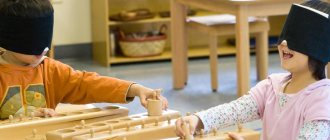Emotional development of a preschooler
Bibliographic description:
Goncharova, N. G. Emotional development of a preschooler / N. G. Goncharova. — Text: direct // Questions of preschool pedagogy. — 2021. — No. 4 (14). — P. 18-20. — URL: https://moluch.ru/th/1/archive/99/3446/ (access date: 11/21/2021).
Unfortunately, the development of a child’s emotional sphere is not always given enough attention, in contrast to his intellectual development. However, as L.S. Vygotsky rightly pointed out, A.V. Zaporozhets, only the coordinated functioning of these two systems, their unity can ensure the successful implementation of any form of activity. Carroll Izard wrote about this: “emotions energize and organize perception, thinking and action.
L. S. Vygotsky wrote about the phenomenon of “dried heart” (lack of feeling) associated with education aimed at intellectual behavior, which has not lost its relevance in our time, when, in addition to the appropriate focus of upbringing and training, “lack of feeling” is promoted by the technology of life, in in which the child participates. Scenes of violence are often shown in the media. Children began to withdraw, read less fiction, and communicate less with adults and peers. Modern children have become less responsive to the feelings of others. Therefore, work aimed at developing the emotional sphere of children is very relevant and important. After all, a child who understands the feelings of others, actively responds to the experiences of others, and strives to help others will not show hostility and aggressiveness in the future.
A vivid assessment of empathy (the ability to emotionally respond to the experiences of another) was given by the famous teacher V. A. Sukhomlinsky: “deaf to others will remain deaf to himself: the most important thing in self-education will be inaccessible to him - the emotional assessment of his own actions...”
In the psychological and pedagogical literature it is noted that emotions and feelings do not exist outside of human cognition and activity, but on the contrary, they arise in the process of activity and influence its course. Thus, based on the above, we note that emotions and feelings accompany all types of human activity and behavior.
Preschool childhood is the initial period for the development of a child’s personality. In the process of development, the emotional sphere of the child changes. His views on the world and relationships with others change. The child is aware of and controls his emotions. Children prefer the company of their peers, as it is characterized by bright emotional richness. The increased emotionality and relaxedness of preschoolers distinguishes them from interaction with adults. “On average, in communication between peers, there are 9–10 times more expressive and facial expressions, expressing a wide variety of emotional states - from furious indignation to wild joy, from tenderness and sympathy to fight. Preschoolers are three times more likely to approve of a peer and nine times more likely to enter into conflict relationships with them than when interacting with adults.” All this indicates that the emotions and feelings of preschoolers are still superficial, unstable, violently and intensely experienced.
But despite all this, in preschool age feelings still dominate all aspects of a child’s life, giving them their own coloring and expressiveness. A preschooler does not yet know how to control his experiences; he almost always finds himself captive to the feeling that has captured him.
Emotions play an important role in children’s lives: they help them perceive reality and respond to it. Manifesting themselves in behavior, they inform the adult that the child likes or upsets him. As the child grows, his emotional world becomes richer and more diverse. From fear and joy, he moves on to a more complex range of feelings: he is happy and angry, delighted and surprised, jealous and sad.
In preschool age, a child learns the language of feelings - socially accepted forms of expressing the subtlest shades of experiences with the help of glances, smiles, gestures, postures, movements, voice intonations, and so on.
On the other hand, the child masters the ability to restrain violent and harsh expressions of feelings. He learns to manage his feelings, express them in a cultural form, and consciously use them, informing others about his experiences, and influencing them.
Based on the above, we can draw the following conclusion:
- The main direction of development of the emotional sphere in a preschooler is the emergence of the ability to manage feelings, that is, arbitrariness of emotional behavior.
- Another direction in the development of feelings is associated with a change in their dynamics and content, when feelings become stable and form higher feelings - moral, aesthetic, cognitive. This is how the preschooler develops compassion, empathy, care for loved ones, a sense of duty, mutual assistance, and responsiveness.
- The development of emotions and feelings is facilitated by all types of child activities, as well as communication with adults and peers.
By accepting the child’s emotional reactions and states, the adult recognizes his right to experience exactly those feelings that he experiences, which further contributes to the child’s awareness of his own emotions.
The main task of the teacher is to ensure the emotional well-being of children in the group. This means that a healthy psychological microclimate must be provided for each child. It is important to win the child over to yourself and the children, then he will have a feeling of confidence. And this contributes to the normal development of the child’s personality.
Therefore, we structured the work as follows:
‒ selected priority areas;
‒ determined the topics of the lessons;
- made a selection of games.
And then we worked in blocks:
- "I am human!"
- "Your Emotions"
- "Social Skills"
The main task of the first block is “I am a man!” - help the child realize his characteristics and preferences, understand that he, like every person, is unique and inimitable. And it doesn’t matter that the child’s capabilities are limited, it is important to constantly support each child in different situations - both success and failure. And help him, believe in himself. Give him confidence that tomorrow he will definitely do what he could not do today.
At an older age, I use the following techniques: conversations, consideration of situations from personal experience, puppet shows, didactic games from the series “My Light, Mirror, Say!”, “Me and My Body”, “Who Am I?”. You can complete the series of these classes by creating an album called “This book is about me!” Here the child depicts in drawings, applications, photographs everything that he has learned about himself.
All the work done helps develop self-confidence in the child, which at an older age develops into self-esteem, and it is very important that it be positive.
The main task of the second block is to teach children to consciously perceive their emotions, feelings and experiences, as well as to understand the emotional state of other people, since this is the most important factor in forming relationships with people.
Older children recognize emotions in graphic images, compare opposite emotions, and analyze their causes. When working on the second block, you can pay attention to fiction, as it introduces the child to a special world of feelings, experiences and emotional discoveries.
The Social Skills block is very important. The main task of this section is to help the child master the rules and norms of behavior in society. After all, how else can we provide a preschooler with a comfortable existence among his peers, how to protect him from the bitterness of loneliness, so that he is surrounded by friends not only in childhood, but also in adulthood.
The topics in this block involve teaching children to analyze the causes of interpersonal conflicts and the ability to regulate them. Work can be carried out on the following topics: “Friends”, “How and why conflicts arise?”, “Joint business”, “Kind words and deeds”, “Tease, offend” and others. You can create problematic situations, this can be achieved with the help of training using Express Help cards.
The methodology of G. B. Stepanova, E. G. Yudina characterizes the development of the social sphere in interaction with adults, peers, as well as the assimilation of norms and requirements (individual profile of social development). By filling out such a profile, you can get a clear picture of the child’s progress in the field of social development, it helps to see gaps, and help build corrective work. The social development of a child is the basis of moral education, civic education, and the formation of a sense of patriotism through love for one’s family, city, and Motherland.
The topic discussed is very significant and relevant. I would like to end it with the words of V.S. Mukhina: “When others treat a child kindly, recognize his rights, show attention to him, he experiences a feeling of confidence and security.” And this is the main thing, since emotional well-being contributes to the normal development of the child’s personality, the development of his positive qualities, friendly attitude towards other people.
Every teacher should know that the comprehensive, full development of the child depends on his pedagogical skills, and this means our future!
Key terms
(automatically generated)
: child, feeling, emotion, older age, adult, preschooler, normal development of a child’s personality, social development, sense of confidence, emotional sphere of a child.
Diagnostics
Basic diagnostic methods for the emotional sphere of children:
- testing
- observation
- survey
- conversation
- survey
- analysis of samples of children's creativity (drawings).
When observing a preschooler, pay attention to factors such as emotional background, mood, degree of expression of emotions, level of emotional mobility. By observing, you can easily notice how rich the child’s emotional background is, whether the child knows how to control his emotions, and whether he is characterized by emotional instability.
Using one of the diagnostic methods or in combination, you can find out:
- How adequate is the preschooler’s reaction to phenomena?
- how he perceives and interprets the states and moods of other people
- the breadth of the range of emotions that the child understands and experiences, the depth of his experiences, ways of conveying emotions through speech;
- Is it appropriate to display emotions during communication?
These methods can be used by both professional child psychologists and kindergarten teachers.
Mistakes on the part of parents
The main problem with a child’s negative emotions is that parents do not understand how to ensure that they develop positive ones. A common mistake parents make when trying to please their children is a huge number of different gifts and toys. This contributes to the fact that the child ceases to experience the joy of receiving new toys and owning them; this seems to him a natural process.
Advice for parents on behavior with childrenThis incorrect approach on the part of the parents directly affects the development of an irresponsible attitude towards things in the child, who will not value what he has and will take all signs of attention for granted. In the future, this attitude will extend to other people's and public things. A small number of toys brings a lot of joy from their possession, and the child takes care of and appreciates them. Subsequently, this develops not only accuracy and thrift as personal qualities, but also instills respect for work.






